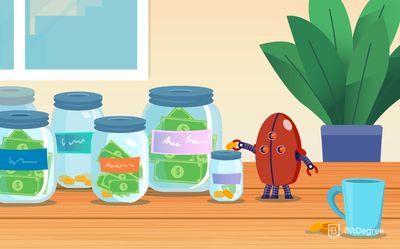Free Airdrop Season 7 is LIVE! Answer fun questions or do simple tasks to earn rewards from the $30K BitDegree prize pool. Participate Now ! 🔥
Did you know that there are various types of Database management systems? The most common ones include relational databases, hierarchical databases, and network databases. If you want to become an expert in this field, you must know the difference between all of them. Stanford Database courses as well as additional research can help you to do just that.
Since you came here, you’ve probably heard about Stanford's three inaugural massive open online courses released in the fall of 2011. Stanford Databases is one of those 3 courses. It consists of 5 smaller self-paced courses. As it is already obvious, this is exactly what we’re going to be focusing on.
You can take a quick glance at those 5 courses that are a part of the Stanford Databases:
- Databases: Introduction to Relational Databases
- Databases: Relational Databases and SQL
- Databases: Advanced Topics in SQL
- Databases: OLAP and Recursion
- Databases: Modeling and Theory
- Databases: Semistructured Data
After introducing Stanford database courses, we will also take a look at a few alternative options that are definitely worthy of your attention:
Now let’s move further and find out why choosing Stanford Database classes online is a good idea.
Table of Contents
- 1. Stanford Database Course: Online VS Traditional Learning
- 2. Databases: Introduction to Relational Databases (Enroll HERE)
- 3. Databases: Relational Databases and SQL (Enroll HERE)
- 4. Databases: Advanced Topics in SQL (Enroll HERE)
- 5. Databases: OLAP and Recursion (Enroll HERE)
- 6. Databases: Modeling and Theory (Enroll HERE)
- 7. Databases: Semistructured Data (Enroll HERE)
- 8. Alternatives to Stanford Database Courses
- 8.1. IBM Data Science Professional Certificate (Enroll HERE)
- 8.2. Data Engineering Foundations Specialization (Enroll HERE)
- 9. Why Should You Enroll in Stanford Database Courses?
- 10. The Benefits of Choosing Stanford Database Courses on edX
- 11. Conclusions
Stanford Database Course: Online VS Traditional Learning
Stanford is a private research university that was founded back in 1885. Stanford is often compared to other prestigious universities, such as Harvard, Yale, or Oxford. The university is among the top fundraising institutions in the country.
Latest Deal Active Right Now:Follow the Datacamp promo code link & get an exclusive 25% OFF Datacamp subscriptions. Act now while the offer is still available!
Stanford is being organized around 7 schools as well as 40 academic departments. The university is well-known among eager-to-learn individuals who want a better future for themselves. After all, it opens up new future opportunities.
Being accepted to Staford is a huge honor. However, that’s the main problem, its acceptance rate is only 4.3%. The number shows that students have lower chances of being accepted to Staford than Yale, Harvard and Princeton. It doesn’t sound very promising, to say the least.
When it comes to Stanford database online courses, every eager-to-learn individual can start learning, as long as there are a computer and internet connection. There are no enrollment exams or additional tests that you need to complete before enrolling in courses.

Another significant benefit of online Stanford courses is that they’re super flexible. You can choose from a variety of self-paced courses that will allow you to learn anywhere and at any time. This is of significant importance for people who already have full-time jobs and families, and simply allow themselves to start studying in traditional institutions of higher education.
Now, let’s talk about prices. Studying at Stanford costs about $70,000 per year, so many students take loans to be able to afford it. This won’t be an issue when it comes to online courses. You should know that all Harvard database courses online that we’ll be discussing today are free of charge. The only thing that’s paid is a certificate, however, it’s something that you can decide if you need.
The final aspect that you’ve probably already thought about is COVID-19. Due to the pandemic, most universities have transferred their classes online. This means that even if you get to Stanford, you won’t be able to have that on-campus experience, participating in various activities after classes, and so on. At least for now.
So why not spend this time learning Stanford database courses online? It’s easily accessible, completely free, and, of course, safe, as you won’t be contacting other students.
It’s evident that there are multiple benefits when it comes to choosing Stanford database classes online, so now it’s time to take a look at the options and help you decide which course to choose first.
Databases: Introduction to Relational Databases (Enroll HERE)
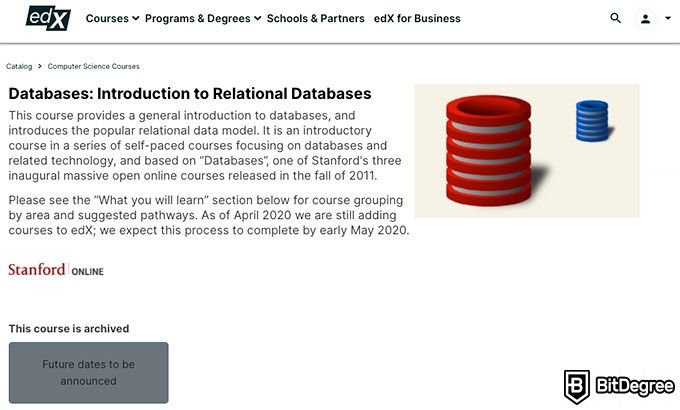
- Platform: edX
- Duration: 1 week (5-10 hours per week)
- Price: FREE
- Certificate: $49
- Level: Introductory
- Apply HERE
The very first course that I would like to discuss is Databases: Introduction to Relational Databases. This course is the very first step you should take if you want to learn more about databases. It will provide you with basic information about databases and will introduce you to the popular relational data model.
This course is introductory level and should take about 1 week or 5-10 hours to complete. It’s quite recommended for those who know nothing about databases and will also prepare you for the further Stanford database courses on this list.
The Stanford introduction to databases course is suitable for beginners, however, computer science foundations should help you to easier understand each of the topics. Also, if you have programming knowledge, it will also come in handy.
To make it more interesting, all Stanford database courses on edX include not only visual and written material but also various quizzes and exercises. What is more, you will be provided with detailed lecture notes, so there’s no need to worry about writing it all down.
The instructor of this and the further 5 courses is the same, after all, it’s a set of courses that will each provide you with knowledge in databases from different angles. Jennifer Widom is the Frederick Emmons Terman Dean of the School of Engineering and the Fletcher Jones Professor in Computer Science and Electrical Engineering at Stanford University.
She has a lot of experience in this and many other fields, so there’s a lot that you can learn. Talking about Jennifer Widom, let’s take at some of her most significant achievements:
- From 2009 to 2014 - Computer Science Department Chair.
- From 2014 to 2016 - School of Engineering Senior Associate Dean.
- Research Staff Member at the IBM Almaden Research Center.
- Joined Stanford in 1993.
- In 2000 received the Guggenheim Fellowship.
- In 2007 received ACM SIGMOD Edgar F. Codd Innovations Award.
Even though there are multiple other achievements that we could talk about, it’s evident that when it comes to Stanford database courses, this is one of the best instructors that you could get.
Databases: Relational Databases and SQL (Enroll HERE)
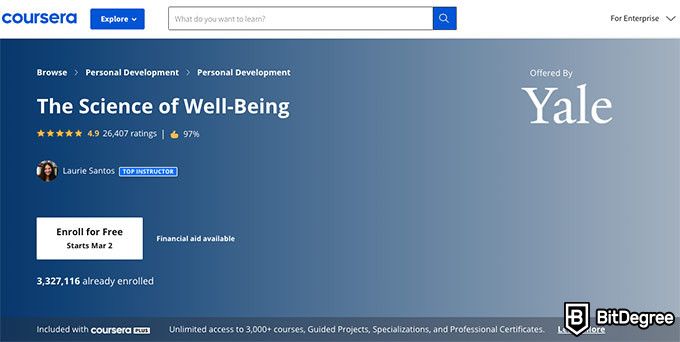
- Platform: edX
- Duration: 2 weeks
- Price: FREE
- Certificate: $49
- Level: Introductory
- Apply HERE
After the Stanford introduction to databases, the very first course that you should take is Relational Databases and SQL. This course is one of the most popular ones when it comes to these 5 Stanford database courses.
This course is best for those who want to gain knowledge in relational databases and master SQL that’s a standard language when it comes to this type of data management system.
The Relational Databases and SQL course is quite a short one (so will be all the other Stanford database courses). It should take you about 2 weeks or 8-10 hours to complete. As I already mentioned, you can enroll in this course completely free. The only thing that’s paid is a certificate of completion. It will cost you $49.
Since edX offers approved and accredited certificates, you can add them to your portfolio or CV to land a better job offer. That being said, the price is completely worth it.
After completing this course you will know more about:
- Relational database model and various concepts related to this type of data management system.
- In-depth understanding of SQL that’s known as the standard query language for relational database management systems.
Even though this course takes only a few weeks to complete, it’s completely worth it!
Databases: Advanced Topics in SQL (Enroll HERE)
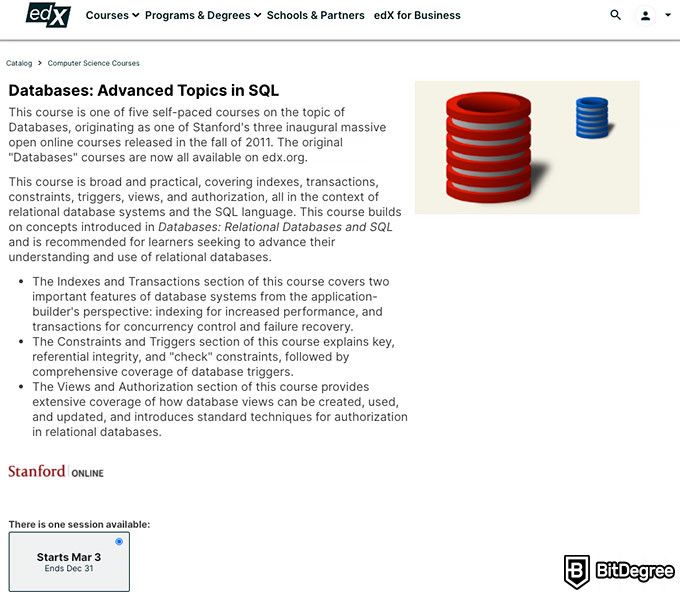
- Platform: edX
- Duration: 2 weeks
- Price: FREE
- Certificate: $49
- Level: Introductory
- Apply HERE
Another course that I want to discuss is Advanced Topics in SQL. Even though it’s quite a short one, it will definitely provide you with in-depth knowledge, including covering indexes, triggers, views, transactions, constraints, and authorization, everything when it comes to relational database systems and the SQL language.
This course is especially recommended for those who want to improve their knowledge of relational databases and find out how to use them. It will cover both theoretical and practical parts. The Advanced Topics in SQL course consists of 3 different sections: The Indexes and Transactions, The Constraints and Triggers, and The Views and Authorization.
Just like the previous one, this course is available on edX - one of the leading MOOC providers. You should be able to complete it within a few weeks when learning about 8-10 hours per week. Even though it can be quite intensive, you can take as much time as you need as it’s completely flexible. The certificate for this course is $49, however, you can enroll completely free.
After completing this course, you will learn:
- How to create indexes for increased query performance.
- Database constraints, including key, referential integrity, and "check" constraints.
- Understand what are database triggers.
- How to use transactions for concurrency control and failure recovery.
- Creating, using, and updating views in relational databases.
- Relational databases authorization.
If you want to find out more about databases and SQL, you can start learning instantly. After all, it’s one of the best Stanford database classes online.
Databases: OLAP and Recursion (Enroll HERE)
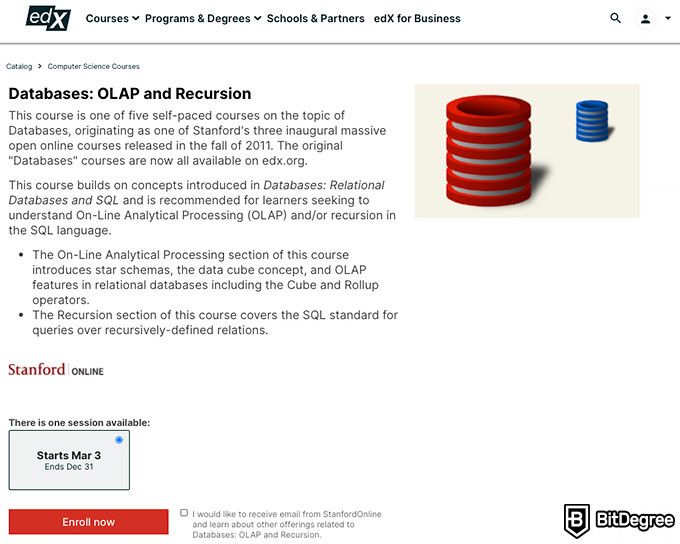
- Platform: edX
- Duration: 2 weeks
- Price: FREE
- Certificate: $49
- Level: Introductory
- Apply HERE
If you want to understand about On-Line Analytical Processing (OLAP) and/or recursion in the SQL language, the OLAP and Recursion course is just the right fit. This course consists of 2 different parts. The On-Line Analytical Processing section will focus on the data cube concept, star schemas, and OLAP features when it comes to relational databases. The Recursion section is focused more on SQL.
This Stanford database class is completely free for all individuals who want to deepen their knowledge of OLAP and recursion. It takes about 8-10 hours to complete, depending on your previous skills and knowledge. Also, you can get a verified and accredited certificate for only $49.
After completing this course, you will be able to understand:
- The data cube concept, star schemas, recreational databases OLAP features, such as the Cube and Rollup operators.
- SQL standards and how they are used when it comes to queries over recursively-defined relations.
Since it’s completely free to start learning this course, do not hesitate and improve your knowledge in databases.
Databases: Modeling and Theory (Enroll HERE)

- Platform: edX
- Duration: 2 weeks
- Price: FREE
- Certificate: $49
- Level: Introductory
- Apply HERE
The Modeling and Theory course includes 3 different parts: The Relational Algebra, The Relational Design Theory, and The Unified Modeling Language. You will learn about the underlying principles and design considerations related to databases.
This course is about 2 weeks long. It can be taken before, after, or in the middle of the Stanford Databases series. Even though no previous knowledge is required, it would be helpful to have a background in data science as well as some programming skills.
After completing this Stanford database online course, you will understand:
- What is relational algebra, how and what it is used for.
- Normal forms and dependency theory in relational databases as the schema design basis.
- What is the Unified Modeling Language (UML) data-modeling component and how can UML diagrams be translated to relations.
There’s a lot to cover in this course, however, the knowledge is completely worth the effort.
Databases: Semistructured Data (Enroll HERE)

- Platform: edX
- Duration: 2 weeks
- Price: FREE
- Certificate: $49
- Level: Introductory
- Apply HERE
The final of the Stanford database course series is SemiStructured Data. Just like all the previous courses, you should be able to complete this one within 2 weeks. Moreover, you can enroll either completely free or choose to get a certificate for $49.
This course consists of 4 different segments that will teach you everything there is to know about semistructured data, including XML Data, JSON Data, XPath as well as XQuery and The XSLT.
This course includes not only theoretical but also practical material that will help you to learn the subject better. What is more, it includes various tests and quizzes that will make it even more interesting.
In this course, you will gain valuable knowledge that you’ll be able to apply in real situations, including:
- The XML model for self-describing and semistructured data, such as DTDs and XML Schema features.
- Find out more about XSLT rule-based language and how it is used.
- Gain knowledge in XPath language for processing XML as well as advanced features of XQuery language.
- Understand more about JSON model for human-readable structured or semistructured data.
All of these terms might sound confusing, however, after completing this and previous Stanford database courses, you’ll understand their meaning, know how they work, and might even be able to apply them in real-life situations.
Alternatives to Stanford Database Courses
As we already discussed the famous Stanford database courses that you’ve been looking for, it’s a great idea to check out a few alternative options that will help you master databases even better.
Since the options include a professional certificate and a specialization, they’re both very in-depth and are suitable for those who are serious about their careers in data management.
Without further ado, let’s take a look at those two options.
IBM Data Science Professional Certificate (Enroll HERE)
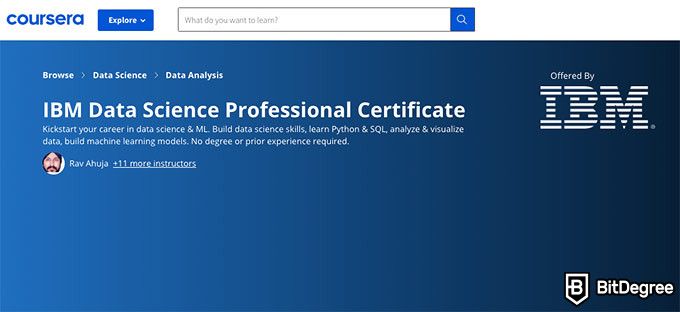
- Type: Professional Certificate
- Platform: Coursera
- Duration: 12 months
- Price: $39 USD per month after trial ends
- Certificate: YES
- Level: Introductory
- Apply HERE
The first alternative to Stanford database online courses is IBM Data Science Professional Certificate. The Certificate is in-depth, you should be able to complete it within 12 months when learning about 4 hours per week. After that, you will gel a professional and accredited certificate that could help you to land a better job offer.
The certificate consists of 9 courses, you will be focusing on understanding what data science is, what tools are being used in this field, the methodology, Python programming language for data science, databases and SQL for data science, data analysis, visualization, and so much more.
Also, it’s important to mention that you don’t need to have any previous knowledge and experience in order to enroll in this IBM Data Science Professional Certificate. It will provide you with all the necessary information.
Here are the skills that you will gain after completing IBM Data Science Professional Certificate:
- Understand what data science is, how the data scientist’s work looks like as well as the methodology needed.
- Learn how to use various tools, languages and libraries that are needed to become a professional data scientist.
- Use Python to analyze and visualize data, clean data sets, and so much more.
- How to apply various data scientist skills in a real-world environment.
IBM Data Science Professional Certificate is more in-depth and takes longer to complete than Stanford database courses, however, it’s completely.
Start the professional certificate NOW.
Data Engineering Foundations Specialization (Enroll HERE)
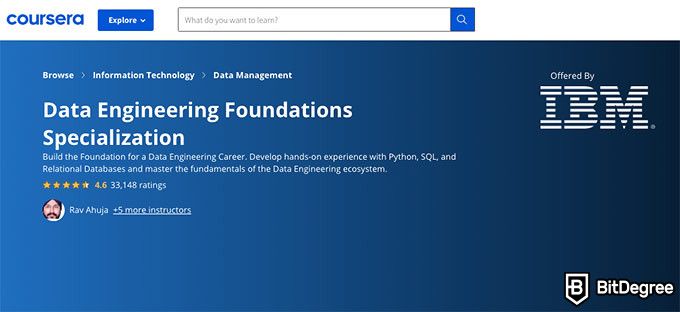
- Type: Specialization
- Platform: Coursera
- Duration: 5 months
- Price: $49 USD per month after trial ends
- Certificate: YES
- Level: Introductory
- Apply HERE
The final option that must be mentioned in this article is Data Engineering Foundations Specialization. It takes about 5 months to complete if you’re learning about 3 hours per week. However, this specialization is completely flexible, so you can learn whenever you have the time. Also, the first 7 days are completely free, however, later it will cost $49 per month.
This specialization is a perfect option for you if you want to get real experience with Python, SQL, and Relational Databases. What is more, it will help you to master the Data Engineering ecosystem.
The Data Engineering Foundations Specialization includes not only theoretical material but will also provide you with hands-on experience through various laboratory works, assignments, quizzes and tests. You’ll be analyzing socio-economic data and will be applying SQL techniques.
The specialization consists of 5 self-paced courses. At first, you’ll be introduced to data engineering, then learn about python for data science, AI and development. Moreover, you’ll be applying your knowledge when working on a project, find out more about relational databases as well as databases and SQL for data science with Python.
In this specialization, you’ll be learning from 6 experts in the field, including Joseph Santarcangelo, Data Scientist at IBM, Sandip Saha Joy, Cognitive Data Scientist, and others.
Once you complete Data Engineering Foundations Specialization, you’ll be familiar with these subjects:
- Understanding Data Engineering Ecosystem and Lifecycle.
- Tips from professionals in data engineering.
- The fundamentals of relational databases, including schemas, designs, tables, constraints, and so much more.
- The basics of Python programming, including working with files, invoking APIsl, using various libraries, logic, and data structures.
- SQL query language, its functions, statements, and more.
So if you’re interested in data engineering and want to deepen your knowledge in databases, this specialization is highly recommended.
Start the specialization certificate NOW.
Why Should You Enroll in Stanford Database Courses?
Besides the fact that Stanford offers top-rated database courses, there are additional reasons for learning about databases.
Databases are used almost everywhere. If you haven’t realized that before, you know it now. It strongly affects the way everything functions in our daily lives - from various weather applications to watching movies online and other more extensive services. Let me provide you with a few examples of how we’re using databases in our daily lives.
First of all, databases are widely used in healthcare. Hospitals store a huge amount of patients’ data that’s protected by complex databases behind it. What is more, you probably noticed that Netflix and other online streaming services provide you with the list of recommended movies and TV services based on your previous preferences. It’s also done using database management technology.
Furthermore, if you’re using Facebook, Instagram, or any other social media platform, you should know that each of them stores user information in databases. The collected information is used to provide you with various recommendations, such as services, businesses, people, and so on. It’s just like with online streaming services.

Also, databases are used in various government agencies that are collecting data for various purposes, such as research. Once data is collected it is then analyzed using complex database software.
There are many other fields where databases are used, including sports, social gaming, finances, and so much more. That said, when you think about it, databases are everywhere around us, even though we do not see them.
It’s obvious that choosing Stanford database courses as well as alternative options that will help you to find out more about databases and learn how they work is completely worth it. Having this knowledge could provide you with amazing future opportunities, positively affect your career, and so much more.
The Benefits of Choosing Stanford Database Courses on edX
edX is one of the best-rated MOOC providers and is the #1 option when it comes to Stanford Database courses. Now, there are a few significant reasons why people choose this platform to learn more about databases and gain other valuable skills. Let’s take a look into those reasons.
- Enroll in Stanford Database courses completely free.
It’s quite surprising to the majority of people, however, you should know that edX offers a variety of courses completely free. In fact, I would say that you can enroll in the majority of them completely free, including Stanford database courses.
Of course, when it comes to professional certificates and programs, they are not available for free.
- Learn at your own pace.
If you’re a busy person and have a lot on your plate then online courses on edX are just the right options for you. edX provides you with hundreds of flexible courses offered by prestigious universities that you’ll be able to learn at your own pace.
Needless to say, if you have a family and a full-time job, edX courses can help you to do it all - learn whenever you have time and are in the mood for it.
- Get verified and accredited certificates.
Even though the majority of online learning platforms offer certificates, only a few of them can provide verified and accredited certifications. The good news is that edX is one of those few MOOC providers.
Since edX certificates are verified and accredited, they’re valued among employers and can help you to take a new turn in your career or even get a better job offer. The certificate can be easily added to your CV and portfolio.
- Choose from a variety of courses offered by prestigious universities.
One of the exceptional edX features is that it partners with leading universities and institutions of higher education that offer professional courses.
This means that you’ll be able to find not only Stanford database courses but also various online classes from other leading universities, such as Columbia University, Cornell University, Massachusetts Institute of Technology, University of California, Boston University, Brown University, and Georgetown University.
- Learn from the experts.
Since the majority of courses available on edX are offered by prestigious universities and other leading institutions, you will be learning from the experts in their field that have years of experience.
Now, if you want to become an expert in a specific field, you also need to learn from the very best. edX provides you with such an opportunity.
As you can see, there are multiple reasons for choosing Stanford database courses online - they’re flexible, accessible to everyone, you can learn from experts and enroll in classes offered by prestigious universities.

Did you know?
Have you ever wondered which online learning platforms are the best for your career?
Conclusions
Even though we cannot see it, databases are all around us - online streaming services, healthcare, government agencies, and many other organizations are using it. Knowledge in databases can open up new career opportunities and lead to a better future.
If you want to gain knowledge and maybe even become an expert on databases in the future, you can start from these Stanford database courses:
- Databases: Introduction to Relational Databases
- Databases: Relational Databases and SQL
- Databases: Advanced Topics in SQL
- Databases: OLAP and Recursion
- Databases: Modeling and Theory
- Databases: Semistructured Data
Also, after completing Stanford database courses, make sure to check out additional options that will help you to master database management even better:
Whichever courses on databases you choose, it’s important to choose not only reliable MOOC providers but also make sure that those courses are offered by trustworthy institutions and professionals in their field. That’s the best way to make sure that you gain valuable and applicable knowledge.
I hope that you found Stanford database online courses that are suitable for your personal wants and needs. Since the majority of offered courses are completely free, you can start learning right now!







